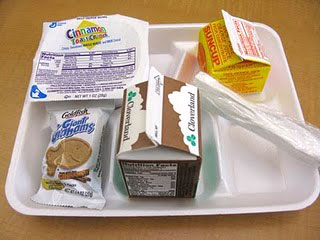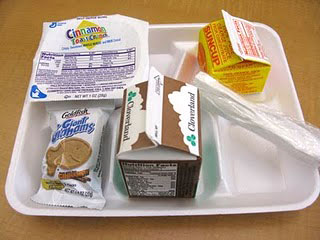 Want some fatty liver disease with that? Typical breakfast in a D.C. public school before the district changed its policies.Photo: Ed BruskeThe biggest news about the Child Nutrition Act pending in Congress isn’t increased funding, or more vegetables and whole grains in school meals. The reason we need this bill passed now is to save children from government standards that are destroying kids’ health.
Want some fatty liver disease with that? Typical breakfast in a D.C. public school before the district changed its policies.Photo: Ed BruskeThe biggest news about the Child Nutrition Act pending in Congress isn’t increased funding, or more vegetables and whole grains in school meals. The reason we need this bill passed now is to save children from government standards that are destroying kids’ health.
Every day, I visit the cafeteria in my daughter’s elementary school here in the District of Columbia and watch a quiet struggle unfold. It’s the same battle schools fight all over the country: trying to provide kids the calories the U.S. Department of Agriculture says they must have, on a budget that won’t cover the cost of healthy food. The result? Meals loaded with sugar — enemy No. 1 in our current epidemic of childhood obesity.
Sugar, and especially the high-fructose corn syrup that proliferates in cheap processed food, has emerged as the leading culprit behind a host of modern ills. It packs fat onto waistlines, raises blood pressure, creates bad cholesterol and unhealthy arteries, primes bodies for diabetes and heart failure, and now is suspected in an outbreak of non-alcoholic fatty liver disease in children.
Right behind smoking, sugar has become the health scourge of our time, contributing greatly to this country’s estimated $147 billion annual tab for weight-related illnesses. Yet in the world of federally-subsidized school meals, sugar not only goes virtually unregulated, but has emerged as the go-to ingredient to boost calories in perpetually under-funded cafeterias.
Take breakfast, for instance. The USDA says that a school breakfast must provide 554 calories for children in elementary school. Where do those calories come from? Well, if you have less than $1 to spend, your breakfast might very well look like the ones that used to be served every day in D.C.: Sugary Apple Jacks cereal topped with strawberry-flavored milk, accompanied by a Pop-Tart, a pack of Giant Goldfish Grahams, and a carton of orange juice.
All together, children as young as five routinely were consuming the equivalent of 15 teaspoons of sugar before classes even started.
This year, D.C. school officials have taken the extraordinary step of eliminating not just flavored milk and sugary cereals, but also those other processed “treats” that were standard fare in the breakfast line. Now we see low-sugar Kashi cereal, organic yogurt, sunflower butter, and cottage cheese on the menu. But how do you make a small blueberry muffin, a scoop of cottage cheese, a carton of low-fat milk and four ounces of orange juice add up to 554 calories?
We’re lucky here in the nation’s capitol. As the result of a “Healthy Schools Act” passed by the D.C. Council earlier this year, we now have 10 cents extra to spend on breakfast and another 10 cents for lunch. Few local jurisdictions have been so generous. That’s why you see cookies and brownies in subsidized school lunches all over the country. The sugar provides a cheap boost in calories. In the Chicago area, parents continue to complain about “brunch for lunch,” meaning pancakes, phony syrup, and cookies posing as the midday meal. Other healthy food advocates despair of getting sugary flavored milk off the menu, because their schools would then fall short of the USDA’s calorie requirements.
The measly 6 additional cents that the U.S. Senate recently approved for school meals as part of its version of the Child Nutrition Act re-authorization won’t solve the problem. But its call for new meal standards might. Under the Senate bill, the “Healthy, Hunger-Free Kids Act,” the USDA would be required to “update meal patterns and nutrition standards” within the next three years. Proposed new standards have already been developed by the Institute of Medicine at the USDA’s behest.
Don’t look for any regulations aimed specifically at sugar. The sugar lobby is too strong for that. Instead, the IOM attempts an end run around sugar’s tyranny over school meals, lowering calorie requirements while boosting the amounts of fruits, vegetables, and whole grains schools must serve. Sugar essentially would get squeezed off the menu.
In fact, the current calorie minimums enforced by the USDA exceed the IOM’s proposed maximums. The calorie requirement for an elementary school breakfast, for instance, would change from that flat 554 calories, to a range: 350 calories up to a maximum of 500. That means 204 calories that cash-strapped schools wouldn’t have to pay for, calories kids might not be exposed to in the form of sugar.
For lunch, the IOM recommends a range of 550 to 650 calories for kids 5 to 10 years of age, compared to the USDA’s current fixed amount of 664. The Institute of Medicine also proposes to raise the percentage of calories that can be derived from calorie-dense fat in school meals, from 30 percent to 35 percent, a move that would further reduce schools’ reliance on sugar and bring the meals program more in line with the federal government’s dietary guidelines.
In addition, this year’s version of the Child Nutrition Act for the first time would give the USDA authority to regulate all foods sold in school, not just in the subsidized meal line, as Tom Laskawy blogged last week. If the agriculture secretary is in a mood to take on the processed-food industry, that could mean no more sugary drinks and snacks in vending machines, no more ice cream bars or fruit roll-ups in a la carte lines.
For healthy school food advocates, the Senate’s trifling 6 cents is hard to swallow. But we need to get over it for now, and make sure the House moves quickly on its version of the Child Nutrition Act, HR 5504.
As we’ve seen here in D.C., a lot can be accomplished just by ridding school meals of unhealthy foods, especially sugar. That’s reason enough to make passage of this bill now an urgent priority.
Get Off Your Ass Alert: Contact your House representative via this handy look-up link and urge him or her to pass the “Improving Nutrition for America’s Children Act” (H.R. 5504) — note that phone calls are more effective than emails, legislative activists say.




